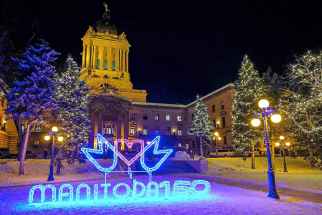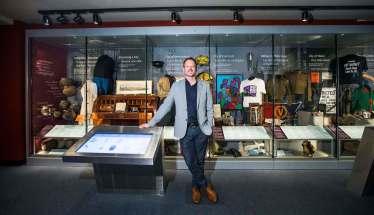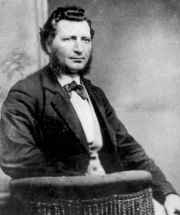One great gallery Winnipeg tells its own story in new Manitoba Museum exhibition, and the display's curator tells his too
Read this article for free:
or
Already have an account? Log in here »
To continue reading, please subscribe:
Monthly Digital Subscription
$0 for the first 4 weeks*
- Enjoy unlimited reading on winnipegfreepress.com
- Read the E-Edition, our digital replica newspaper
- Access News Break, our award-winning app
- Play interactive puzzles
*No charge for 4 weeks then price increases to the regular rate of $19.00 plus GST every four weeks. Offer available to new and qualified returning subscribers only. Cancel any time.
Monthly Digital Subscription
$4.75/week*
- Enjoy unlimited reading on winnipegfreepress.com
- Read the E-Edition, our digital replica newspaper
- Access News Break, our award-winning app
- Play interactive puzzles
*Billed as $19 plus GST every four weeks. Cancel any time.
To continue reading, please subscribe:
Add Free Press access to your Brandon Sun subscription for only an additional
$1 for the first 4 weeks*
*Your next subscription payment will increase by $1.00 and you will be charged $16.99 plus GST for four weeks. After four weeks, your payment will increase to $23.99 plus GST every four weeks.
Read unlimited articles for free today:
or
Already have an account? Log in here »
Hey there, time traveller!
This article was published 02/01/2020 (2171 days ago), so information in it may no longer be current.
Roland Sawatzky’s career path to becoming an anthropologist was set when he was in grade school.
In conversation
With Roland Sawatzky, Curator, Manitoba Museum
They are familiar faces at art shows, film screenings, theatre premières and music venues; but how well do you know the people responsible for upholding Winnipeg’s reputation as an artistic city? In this series, the Winnipeg Free Press sits down with those working in the city’s arts community to find out what inspires them in and out of the office.
The curator of history at the Manitoba Museum recalls his mother getting a National Geographicsubscription. “I was about eight years old and I was flipping through a story about archeology. My mind just opened right up and I thought, ‘That’s it. That’s what I have to do.’ “
Unlike most childhood obsessions, he stuck with it. After graduating from Oak Park High School, he went on to get his BA in anthropology from the University of Winnipeg, an MA in anthropology from the University of South Carolina and a PhD in archeology from Simon Fraser University in Burnaby, B.C.
Sawatzky, 49, is the main curator behind the museum’s Winnipeg Gallery, which opened Nov. 1. The first new permanent exhibition since 2003, it’s part of the museum’s Bringing Our Stories Forward capital campaign, which will see the renewal of 42 per cent of its galleries.
The Winnipeg Gallery features an interactive, state-of-the-art 4K map showing the city’s expansion over decades, a Personality Wall of notable Winnipeggers, historical and current stories from newcomers, an artifact wall dealing with seven themes — City of Celebration, City of Water, Military in Winnipeg, City of Contrasts, City of Newcomers, Becoming a City, and Indigenous Homeland — and a timeline theatre, showing a chronological history of Winnipeg through still images.
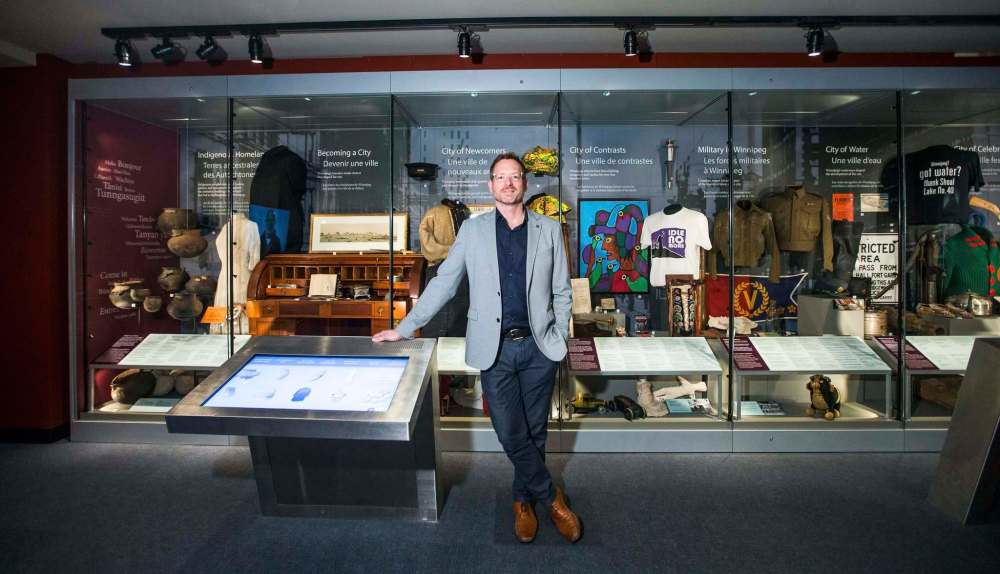
It’s not a large space, but one could easily spend a few hours absorbing all the information on offer, the stories it has to tell.
Sawatzky, a father of two — a son, 16, and a daughter, 12 — also curated the Winnipeg General Strike exhibit at the museum and thinks the centenary of that 1919 event has sparked new interest in the history of our city.
“People have a lot of questions about this town — Why is it the way it is? Why is it here at all? — and I think this gallery is a really good place to start.”
The curator sat down in the Winnipeg Gallery to talk to the Free Press about his work, his background and his love of dance.
Jill Wilson: How often does a curator get the opportunity to create a whole permanent gallery from scratch?
Roland Sawatzky: It’s a once-in-a-career chance, absolutely. It’s very exciting. Of course, it wasn’t just me; there’s a whole team of curators and people involved in the project.
Jill Wilson: Why was it important to have a gallery specifically dedicated to Winnipeg?
Roland Sawatzky: There are a lot of reasons. We have, what, 1.1, 1.2 million people in the province? The majority of those people live in Winnipeg, but there’s no history about Winnipeg done anywhere; there’s no Winnipeg museum. It felt like something that should have been done a long time ago.
Jill Wilson: You went to school all over the place. Why did you come back to Winnipeg?
Roland Sawatzky: I didn’t really intend to, though I wasn’t against it. I was doing my PhD at Simon Fraser and there were some questions I wanted to investigate about how architecture works in a domestic space, how that works to instil cultural values and how that changes over time. I realized that Mennonite house barns in Manitoba had not been studied in that way — or in any way, really — so I thought that might be an interesting direction to go in.
That’s my background, so I know something about it already… so that’s how I ended up coming back to Manitoba. And then I got married.
Jill Wilson: How did you meet your wife?
Roland Sawatzky: Oh gosh, when we were 16! We met in high school, but not the same high school, and we were always very close. But we got married many years after that. She’s a graphic designer. She runs her own business and does a lot of work with museums, does different exhibits, does websites and she does books.
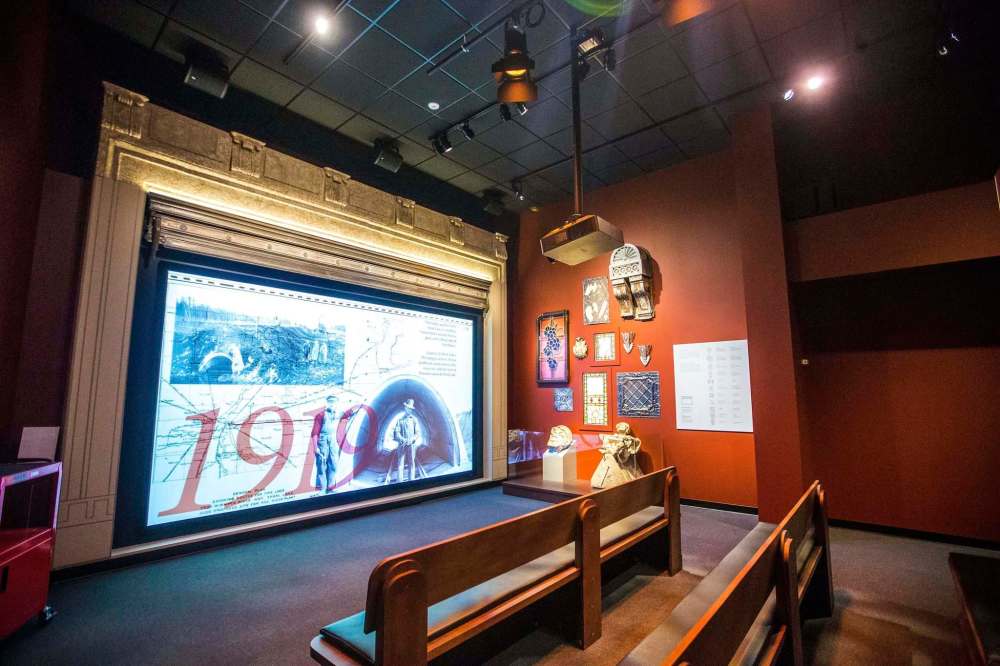
Jill Wilson: You have a Mennonite background and you worked at the Mennonite Heritage Village for many years. How important is being Mennonite to your daily life?
Roland Sawatzky: It’s part of my belief system and also my cultural background. My kids go to a private Mennonite school, Westgate, and I attend a Mennonite church. So it’s a big part of my personal life, yes.
Jill Wilson: Did you go on a mission as a youth?
Roland Sawatzky: I did volunteer work with Mennonite Disaster Service when I was 18, after high school. I went to Kansas, Texas and Kentucky for six months. I was totally green, I didn’t know anything about construction, but with guidance, I think I was able to help, eventually. And then when I was a bit older, I volunteered in Paraguay — both my parents are from Paraguay — and I worked at the leper colony and an Indigenous colony there.
Jill Wilson: If you were showing a tourist around Winnipeg, where would you take them (other than the museum, obviously)?
Roland Sawatzky: The Exchange District, for sure, because there’s so much to see and learn there; so much happened there. It’s a beautiful place and I think we have a real gem here in the centre of Winnipeg that’s sometimes overlooked. In a lot of North American cities, it’s all gone. Another place would be The Forks. It’s a huge success story for Winnipeg and for Manitoba — to build that out of a derelict railyard is pretty special.
Jill Wilson: Does collecting artifacts for your job make you look at the everyday objects in your life differently? Do you assess your own belongings for their future worth?
Roland Sawatzky: Yeah, I’ve always been like that a bit. I’m a collector of things; I try not to hoard. When you’re doing archeology, it’s all important, because archeology is mostly old stuff that’s been thrown away. But it’s the patterns that you find that are interesting, that say something interesting about society. The stuff I have at home feels very personal, it doesn’t necessarily feel like it’s going to have that social importance over time, but it might to a future curator.
Jill Wilson: Are there any personal objects that are particularly meaningful to you, that you’d save if there was a house fire?
Roland Sawatzky: I don’t think I have anything that’s important to me like that. But my father-in-law is a ceramicist, working in porcelain, and anything of his that’s in our house is meaningful to us, because it’s beautiful and he made it and he’s part of our life.
Jill Wilson: Do you have pets?
Roland Sawatzky: We have a cat called Hansel. He’s very big. I don’t know how much he weighs, when he stands up (on his back legs) he comes up to here (indicates hip-height).
Jill Wilson: I hear you like to tango.
Roland Sawatzky: Yes! I’ve been listening to tango music since I was in my early 20s. About five years ago a friend invited us to go take a lesson and we’ve been hooked ever since. We go almost every week. My wife and I are part of a group called Tango Salon Winnipeg, at Drop In Dance on Portage Avenue. We bring in maestros from other parts of the world, master dancers that come for a week or two, and then we have special classes with them.
Jill Wilson: Are there other kinds of music you’re interested in?
Roland Sawatzky: It’s more about quality than genre for me. I really like baroque music and I like industrial music quite a bit.
Jill Wilson: Do you play music?
Roland Sawatzky: No (laughs). I’m not talented that way.
Jill Wilson: What’s the best part of your job? What’s the biggest challenge?
Roland Sawatzky: The best part is I learn something every day. It’s never-ending. And one of the most challenging things is keeping up with the demands of the job, which is a good thing in a way. A lot of people have a lot of questions, we have a lot of offers of donations, lots of projects, I have my own research. Just keeping up with that and doing it in a balanced way.
jill.wilson@freepress.mb.ca
Twitter: @dedaumier

Jill Wilson writes about culture and the culinary arts for the Arts & Life section.
Our newsroom depends on a growing audience of readers to power our journalism. If you are not a paid reader, please consider becoming a subscriber.
Our newsroom depends on its audience of readers to power our journalism. Thank you for your support.
History
Updated on Wednesday, January 8, 2020 5:48 PM CST: Corrects school name

